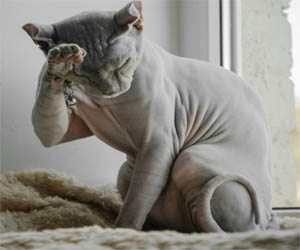


Deciphering Cat Sleeping Patterns

Cats are renowned for their love of sleep, and their sleeping patterns are a topic of fascination and wonder for cat owners. It's not uncommon to find your feline friend dozing throughout the day, in seemingly random and unusual places. In this article, we'll explore the intriguing world of cat sleeping patterns, including the reasons behind their need for sleep and the mysteries that shroud their restful hours.
1. Cats Are Natural Sleepers: Cats are crepuscular animals, which means they are most active during dawn and dusk. Their natural hunting instincts dictate their active periods, and they typically sleep during the day and night. A cat's need for sleep is deeply ingrained in their biology, and they can sleep anywhere from 12 to 16 hours a day, depending on factors like age and activity level.
2. The Power Napper: Cat sleep is characterized by numerous short naps rather than one long, continuous sleep cycle. This style of sleeping is believed to be rooted in their wild ancestry, where they needed to remain vigilant to avoid predators or catch prey at a moment's notice.
3. Comfort Is Key: Cats seek comfort and safety in their choice of sleep locations. You may find your cat curling up in sunny spots to keep warm or seeking out secluded, high-up locations where they can rest undisturbed. Cardboard boxes, windowsills, and cozy nooks are all popular cat nap spots.
4. Cats Dream Too: Like humans, cats experience different stages of sleep, including REM (Rapid Eye Movement) sleep, during which they may dream. You might notice their paws twitching or their whiskers quivering during REM sleep, suggesting that they're actively dreaming.
5. Kittens Sleep More: Kittens and young cats require more sleep than their adult counterparts, with some kittens sleeping as much as 20 hours a day. This extended sleep period is essential for their rapid growth and development.
6. Factors Influencing Sleep: A cat's sleeping patterns can be influenced by several factors, including their health, age, environment, and routine. Changes in any of these areas can impact their sleep habits. Stress, illness, or discomfort can also affect the quality and duration of their sleep.
7. Cat Naps Or Catnaps: Cats often take short, frequent naps rather than one long sleep. These catnaps allow them to conserve energy, remain alert, and quickly respond to changes in their environment. It's not unusual for a cat to wake up, groom itself, and go back to sleep within a short time frame.
8. Sleeping For Survival: Sleeping is crucial for a cat's survival. It helps them recharge their energy, maintain their physical health, and remain mentally sharp. The ability to sleep soundly is a sign of a safe and secure environment for a cat.
9. Maintaining Sleep Quality: To ensure that your cat enjoys high-quality sleep, provide them with a comfortable, clean, and quiet sleeping environment. Ensure their bed or sleeping area is located away from disturbances and excessive noise.
Cat sleeping patterns are a combination of instinct, biology, and environmental factors. Understanding and respecting your cat's need for sleep is essential for their overall well-being. By providing a safe and comfortable environment and respecting their natural sleep patterns, you can ensure that your feline friend enjoys the rest they need to stay happy, healthy, and alert during their active hours.






 Unwavering Loyalty: One of the defining features of dog companionship is the unwavering loyalty dogs offer to their human counterparts. Dogs are known for their unbreakable devotion and the deep sense of trust they place in their owners. This loyalty creates a bond built on a foundation of mutual respect and love, a connection that can weather the storms of life.
Unwavering Loyalty: One of the defining features of dog companionship is the unwavering loyalty dogs offer to their human counterparts. Dogs are known for their unbreakable devotion and the deep sense of trust they place in their owners. This loyalty creates a bond built on a foundation of mutual respect and love, a connection that can weather the storms of life.
A Skeptical Perspective
 Skeptics also emphasize the lack of empirical evidence for Nostradamus' supposed prophetic abilities. They argue that belief in his predictions is largely rooted in confirmation bias, where believers selectively focus on the handful of quatrains that appear to match historical events while ignoring the majority that do not. The scientific method and the principles of critical thinking, which demand empirical evidence and verifiable predictions, are often conspicuously absent from the believers' claims.
Skeptics also emphasize the lack of empirical evidence for Nostradamus' supposed prophetic abilities. They argue that belief in his predictions is largely rooted in confirmation bias, where believers selectively focus on the handful of quatrains that appear to match historical events while ignoring the majority that do not. The scientific method and the principles of critical thinking, which demand empirical evidence and verifiable predictions, are often conspicuously absent from the believers' claims.
Moreover, critics highlight the historical context in which Nostradamus lived. His era was marked by political, religious, and social turmoil, and his quatrains can be viewed as a reflection of the uncertainties and anxieties of his time. Skeptics argue that his writings may have been more about capturing the spirit of the era than providing specific glimpses of the future. They maintain that the events he purportedly predicted can often be seen as general reflections of the historical climate of his time.
Another common target for debunking is the selective use of Nostradamus' quatrains by believers.
Unraveling The Conspiracy
 The Government Cover-Up Theory
The Government Cover-Up Theory
The theory of government involvement in crop circles centers around the idea that some circles are not the work of hoaxes or natural forces but rather secretive experiments conducted by government agencies. Proponents of this theory claim that governments are using crop circles to test advanced technologies, including anti-gravity systems and energy sources.
Evidence And Anecdotes
Conspiracy theorists point to several pieces of evidence to support their claims. They cite instances where military personnel were allegedly seen near crop circle formations shortly after they appeared. Some claim that unusual equipment was used to create the circles, equipment that goes beyond what ordinary hoaxers would possess.
Government Response
The official stance of governments around the world is that crop circles are primarily the result of human-made hoaxes. They argue that there is no substantial evidence to support the conspiracy theory. However, this official position fuels suspicions for some who believe the government is actively covering up its involvement in creating or studying crop circles.
Possible Explanations
Skeptics of the government cover-up theory point out that there is a wealth of scientific evidence supporting the natural or human-made origin of crop circles. They argue that intricate crop circle designs can be achieved with simple tools and knowledge of geometry. Additionally, many crop circle enthusiasts and researchers focus on the artistic and geometric aspects of the phenomena rather than attributing them to government experiments.
A Comprehensive Guide To Feline Well-Being
 Cat-Proof Your Home: Make your living space safe for your new feline friend. Remove hazards, secure toxic substances, and create cozy hideaways where your cat can retreat.
Cat-Proof Your Home: Make your living space safe for your new feline friend. Remove hazards, secure toxic substances, and create cozy hideaways where your cat can retreat.
Essential Supplies: Ensure you have the necessary supplies, including a litter box, food and water dishes, a scratching post, toys, and a comfortable bed.
Providing Nutrition And Hydration
Proper nutrition is crucial for your cat's health and well-being:
High-Quality Cat Food: Choose high-quality cat food that meets your cat's specific dietary needs. Consult with your veterinarian to determine the best diet for your cat's age, activity level, and any specific health concerns.
Fresh Water: Ensure your cat has access to fresh, clean water at all times. Cats can be picky about their water source, so consider a cat water fountain if your cat prefers running water.
Litter Box Maintenance
A clean litter box is essential for your cat's hygiene and happiness:
Regular Cleaning: Scoop the litter box daily and change the litter regularly to keep it clean and odor-free.
Appropriate Placement: Place the litter box in a quiet and accessible location where your cat can easily find it.
Veterinary Care
Regular veterinary care is vital for your cat's health:
Routine Check-Ups: Schedule regular check-ups with a veterinarian to monitor your cat's health, receive vaccinations, and address any health concerns.
Preventive Care: Discuss preventive measures such as vaccinations, flea and tick control, and dental care with your veterinarian.
A Sustainable Solution For A Greener Future
 Biogas And Anaerobic Digestion
Biogas And Anaerobic Digestion
Another waste-to-heat method involves the conversion of organic waste into biogas through anaerobic digestion. In this process, microorganisms break down organic matter in the absence of oxygen, producing biogas, which is primarily composed of methane. This biogas can be used as a renewable fuel for heating, whether in residential, commercial, or industrial applications.
Municipal Solid Waste-To-Energy
Waste-to-energy facilities that convert municipal solid waste into electricity often capture and utilize the waste heat generated during the process. This waste heat can be channeled into district heating systems, thereby providing a sustainable and efficient way to meet the heating needs of communities.
Environmental And Economic Benefits
Renewable heat from waste offers numerous environmental and economic advantages. Firstly, it reduces the demand for non-renewable heating sources, such as natural gas and oil, which helps lower carbon emissions and combat climate change. Additionally, it contributes to waste diversion, reducing the pressure on landfills and minimizing their environmental impact.
From an economic perspective, utilizing waste materials for heat generation can create jobs in waste collection, transportation, and processing, as well as in the design and maintenance of heating systems. This not only bolsters local economies but also provides an opportunity for sustainable development.
Challenges And Considerations
While renewable heat from waste holds tremendous promise, it is not without its challenges. Factors such as waste composition, technology efficiency, and regulatory standards all play a crucial role in the successful implementation of these systems.
The Profound Benefits Of Lucid Dreaming
 Enhanced Problem-Solving: Lucid dreaming can be a powerful tool for creative problem-solving. Dreamers can intentionally explore solutions to real-world challenges within the dream state. The dream world, free from the constraints of reality, often offers fresh and innovative perspectives that can be applied to waking life.
Enhanced Problem-Solving: Lucid dreaming can be a powerful tool for creative problem-solving. Dreamers can intentionally explore solutions to real-world challenges within the dream state. The dream world, free from the constraints of reality, often offers fresh and innovative perspectives that can be applied to waking life.
Overcoming Nightmares: For those plagued by recurrent nightmares, lucid dreaming provides a means to take control of the dream and transform it into a positive or neutral experience. This can be an empowering way to combat night terrors and reduce sleep disturbances.
Personal Growth: Lucid dreaming opens a gateway to self-discovery. By delving into the subconscious, individuals can gain profound insights into their own desires, fears, and motivations. This self-awareness can foster personal growth and greater self-acceptance.
Unraveling The Mysteries Within
 Emotions, too, hold a place of great significance in the realm of the human mind. The mind can generate a vast spectrum of emotions, from love and joy to fear and sorrow. The secrets of emotional processing and the intricate neural pathways that govern these feelings continue to be a focal point of scientific research. Understanding the complexities of emotional intelligence and regulation remains a challenge, but it is a crucial step toward a deeper comprehension of the human psyche.
Emotions, too, hold a place of great significance in the realm of the human mind. The mind can generate a vast spectrum of emotions, from love and joy to fear and sorrow. The secrets of emotional processing and the intricate neural pathways that govern these feelings continue to be a focal point of scientific research. Understanding the complexities of emotional intelligence and regulation remains a challenge, but it is a crucial step toward a deeper comprehension of the human psyche.
Memory, another cornerstone of the human mind, conceals its own set of secrets. The brain's capacity to store and retrieve vast amounts of information is awe-inspiring, and yet, the mechanisms of memory formation and recall remain partially shrouded in mystery. Researchers are constantly exploring the brain's intricacies to uncover the secrets behind how we remember and why we forget.
The human mind also holds the power of perception. It processes the sensory input from our environment, shaping our view of the world. Perception is not a passive process; it involves the mind's interpretation of sensory data. The study of perception has revealed the mind's role in shaping our understanding of reality and how it can be influenced by our past experiences, beliefs, and expectations.
Consciousness itself is one of the most profound secrets of the human mind. While we experience it every day, the nature of consciousness and its origins remain a subject of ongoing debate and exploration.